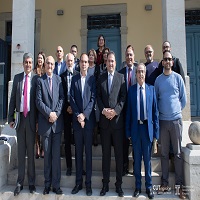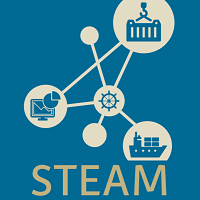In the week from February 17 to 21, the UNESCO and ERA Chairs on Digital Cultural Heritage at the Cyprus University of Technology (CUT), Limassol, hosted four scientists and academicians from Slovenia, University of Ljubljana (UL), Faculty of Civil and Geodetic Engineering, Department of Geodesy: Dr. Dejan Grigillo, Dr. Klemen Kozmus Trajkovski, Dr. Tilen Urbančič and Dr. Dušan Petrovič. Cooperation between both institutions started years ago and was initiated by Dr. Marinos Ioannides from CUT and Dr. Roko Žarnić from UL. The visit was enabled and financed by EU Erasmus+ programme, which supports cultural, scientific and professional exchange of students, teachers, staff and knowledge within education institutions in Europe. The main goal was comparing and exchanging praxis and procedures at documenting cultural heritage monuments.
Therefore, both teams from UL and CUT surveyed three selected important cultural heritage monuments in Cyprus: Paphos Castle, Petra tou Romiou, also known as Aphrodite's Rock and Karmiotissa church in Limassol. The monuments were photographed from Unmanned Aerial Vehicle (UAV) and scanned with Terrestrial Laser Scanner (TLS) from outside and inside. Hundreds captured UAV images and TLS point clouds from tenths stands enable creation of geometrically correct and precise 3D model, which can serve as documentation for long time preservation, status inspection and maintenance works, but also for attractive presentations, virtual visits and animations for tourism. At both objects control points network on and around the objects were established and measured with combination of GNSS and classical geodetic measurements. These points enable placing models into the right position according to other spatial data, but also to estimate the geometrical accuracy of the created models. Teams from both universities used different equipment (UAV, TLS) and also different applications for data manipulation and 3D modelling, but in generally procedures are similar, so both results should lead to high accurate and comprehensive 3D models. Thus, comparison of final 3D models, which will be completed in the next weeks could help both teams to improve their methods and present all the results in a joint event in Limassol.
In the time of their short visit they had the opportunity to meet CUT Rector and many other researches, academicians and administrative staff as well as the Major of Limassol. We were also warmly hosted by Dr. Evros Alexandrou, the Honorary Consul General of the Republic of Slovenia in Cyprus, who introduced us with organizers of the famous Limassol festival at its start in City Hall.
The visit was excellently organised and hosted by Dr. Marinos Ioannides and his colleagues from Digital Heritage Research Lab at CUT and it can lead to further cooperation and exchange between both institutions.
STEAM (Sea Traffic Management in the Eastern Mediterranean) Νewsletter
In the week from February 17 to 21, the UNESCO and ERA Chairs on Digital Cultural Heritage at the Cyprus University of Technology (CUT), Limassol, hosted four scientists and academicians from Slovenia, University of Ljubljana (UL), Faculty of Civil and Geodetic Engineering, Department of Geodesy: Dr. Dejan Grigillo, Dr. Klemen Kozmus Trajkovski, Dr. Tilen Urbančič and Dr. Dušan Petrovič. Cooperation between both institutions started years ago and was initiated by Dr. Marinos Ioannides from CUT and Dr. Roko Žarnić from UL. The visit was enabled and financed by EU Erasmus+ programme, which supports cultural, scientific and professional exchange of students, teachers, staff and knowledge within education institutions in Europe. The main goal was comparing and exchanging praxis and procedures at documenting cultural heritage monuments.
Therefore, both teams from UL and CUT surveyed three selected important cultural heritage monuments in Cyprus: Paphos Castle, Petra tou Romiou, also known as Aphrodite's Rock and Karmiotissa church in Limassol. The monuments were photographed from Unmanned Aerial Vehicle (UAV) and scanned with Terrestrial Laser Scanner (TLS) from outside and inside. Hundreds captured UAV images and TLS point clouds from tenths stands enable creation of geometrically correct and precise 3D model, which can serve as documentation for long time preservation, status inspection and maintenance works, but also for attractive presentations, virtual visits and animations for tourism. At both objects control points network on and around the objects were established and measured with combination of GNSS and classical geodetic measurements. These points enable placing models into the right position according to other spatial data, but also to estimate the geometrical accuracy of the created models. Teams from both universities used different equipment (UAV, TLS) and also different applications for data manipulation and 3D modelling, but in generally procedures are similar, so both results should lead to high accurate and comprehensive 3D models. Thus, comparison of final 3D models, which will be completed in the next weeks could help both teams to improve their methods and present all the results in a joint event in Limassol.
In the time of their short visit they had the opportunity to meet CUT Rector and many other researches, academicians and administrative staff as well as the Major of Limassol. We were also warmly hosted by Dr. Evros Alexandrou, the Honorary Consul General of the Republic of Slovenia in Cyprus, who introduced us with organizers of the famous Limassol festival at its start in City Hall.
The visit was excellently organised and hosted by Dr. Marinos Ioannides and his colleagues from Digital Heritage Research Lab at CUT and it can lead to further cooperation and exchange between both institutions.


